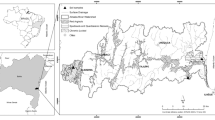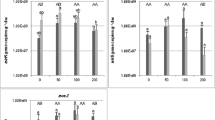Abstract
In both hydroculture experiments and a greenhouse trial the combined effects of flooding and high iron levels on the growth and occurrence of iron toxicity were investigated in threeRumex species having different flood tolerance.
In a hydroculture experiment the plants were subjected to different FeCl2 concentrations and anaerobiosis. At solution iron concentrations exceeding 750 μM, the growth rate of the flood-intolerantR. thyrsiflorus was sharply decreased. The root system was most negatively affected. Differences between the investigated species could be most likely explained from differences in root porosity and are thus closely related to a differential internal oxygen supply to the root systems.
In a greenhouse experiment soil flooding was combined with the addition of different ferrous iron concentrations to the soil solution. Flooding in combination with the addition of 5 mM ferrous iron did not result in a significant decrease in biomass production of any of the investigatedRumex species, in spite of the fact that several types of shoot iron toxicity were perceived. Especially at high iron levels significant amounts of ‘bronzing’ spots on the leaves of all species were observed. Petiole iron toxicity symptoms, which result in a sagging of the petioles, was most clearly observed in the flood-intolerantR. thyrsiflorus.
Although the hydroculture experiments revealed a severe effect of anaerobiosis and high iron levels on the root development and plant growth rate of especially the flood-intolerantR. thyrsiflorus, no such adverse effects were registered in the greenhouse experiments in neither of the species. This is most probably due to the fact that under greenhouse conditions theRumex species are able to locally immobilize iron by oxidation, thereby avoiding the actual iron stress. Since biomass production was hardly affected under greenhouse conditions, it is concluded that high iron levels in the soil solution are of minor importance in the different flood tolerance of theRumex species. It also indicates that great care has to be taken in the interpretation of hydroculture experiments to the actual effect of the suggested stress conditions under greenhouse or natural conditions.
Similar content being viewed by others
References
Armstrong W and Boatman D J 1967 Some field observations relating the growth of bog plants to conditions of soil aeration. J. Ecol. 55, 101–110.
Armstrong W and Webb T 1985 A critical oxygen pressure for root extension in rice. J. Exp. Bot. 36, 1573–1582.
Benckiser G, Santiago S, Neue H U, Watanabe I and Ottow J C G 1984 Effect of fertilization on exudation, dehydrogenase activity, iron-reducing populations and Fe2+ formation in the rhizosphere of rice (Oryza sativa). Plant Physiol. 69, 1161–1164.
Bienfait H F 1989 Prevention of stress in iron metabolism of plants. Acta Bot. Neerl. 38, 105–129.
Chen C C, Dickson J B and Turner F T 1980 Iron coatings on rice roots: Morphology and models of development. Soil. Sci. Soc. Am. J. 44, 1113–1119.
Fargeria N K and Rabelo N A 1987 Tolerance of rice cultivars to iron toxicity. J. Plant Nutr. 10, 653–661.
Foy C D, Chaney R L and White M C 1978 The physiology of metal toxicity in plants. Annu. Rev. Plant Physiol. 29, 511–566.
Hoagland D R and Arnon D I 1950 The water-culture method for growing plants without soil. Circ. Calif. Agric. Exp. Stn. 347. Univ. of California, Berkeley, U.S.A.
Howeler R H 1973 Iron-induced organing disease of rice in relation to physico-chemical changes in a flooded oxisol. Soil Sci. Soc. Am. Proc. 37, 898–903.
Jones H E 1971 Comparative studies of plant growth and distribution in relation to waterlogging. II. An experimental study of the relationship between transpiration and uptake of iron inErica tetralix L. J. Ecol. 59, 583–591.
Kuraev V N 1966 Effects of various concentrations of ferrous iron in culture solution on the growth and development of agricultural plants. Agrochimica 12, 110–117.
Laan P, Berrevoets M J, Lythe S, Armstrong W and Blom C W P M 1989a Root morphology and aerenchyma formation as indicators of the flood-tolerance ofRumex species. J. Ecol. 77, 693–703.
Laan P, Smolders A, Blom C W P M and Armstrong W 1989b The relative roles of internal aeration radial oxygen losses, iron exclusion and nutrient balances in flood-tolerance ofRumex species. Acta. Bot. Neerl. 38, 131–145.
Laan P, Tosserams M, Blom C W P M and Veen B W 1990 Internal oxygen transport inRumex species and its significance for respiration under hypoxic conditions. Plant and Soil 122, 38–46.
Ottow J C G, Benckiser G and Watanabe I 1982 Iron toxicity of rice as multiple nutritional soil stress. Trop. Agric. Res. Series 15, 167–179.
Ponnamperuma F N 1972 The chemistry of submerged soils. Adv. Agron. 24, 29–96.
Ponnamperuma F N 1984 Effects of flooding on soils.In Flooding and Plant Growth. Ed. T T Kozlowski. pp 9–45. Academic Press, London.
Ponnamperuma F N, Bradfield R and Peech M 1955 Physiological disease of rice attributable to iron toxicity. Nature 175, 265.
Tadano T 1975 Devices of rice roots to tolerate high iron concentrations in growth media. Jap. Agric. Res. Quat. 9, 34–39.
Tanaka A, Loe R and Navasero S A 1966 Some mechanisms involved in the development of iron toxicity symptoms in the rice plant. Soil. Sci. Plant Nutr. 12, 158–164.
Tanaka A, Mulleriyawa R P and Yasu T 1968 Possibility of hydrogen sulfide induced iron toxicity of the rice plant. Soil. Sci. Plant Nutr. 14, 1–6.
Taylor G J, Crowder A A and Rodden R 1984 Formation and morphology of an iron plaque on the roots ofTypha latifolia L. grown in solution culture. Am. J. Bot. 71, 666–675.
Van Diggelen J 1988 A comparative study on the ecophysiology of salt marsh halophytes. Ph.D. Thesis, Free University, Amsterdam.
Wheeler B D, Al-Farraj M M and Cook R E D 1985 Iron toxicity to plants in base-rich wetlands: Comparative effects on the distribution and growth ofEpilobium hirsutum L. andJuncus subnodulosus Schrank. New Phytol. 100, 653–669.
Yoshida S and Tadano T 1978 Adaption of plants to submerged soils.In Crop Tolerance to Suboptimal Land Conditions. Ed. G A Jung. pp 233–256. ASA, CSSA, Madison, WI.
Author information
Authors and Affiliations
Rights and permissions
About this article
Cite this article
Laan, P., Smolders, A. & Blom, C.W.P.M. The relative importance of anaerobiosis and high iron levels in the flood tolerance ofRumex species. Plant Soil 136, 153–161 (1991). https://doi.org/10.1007/BF02150046
Received:
Revised:
Issue Date:
DOI: https://doi.org/10.1007/BF02150046




